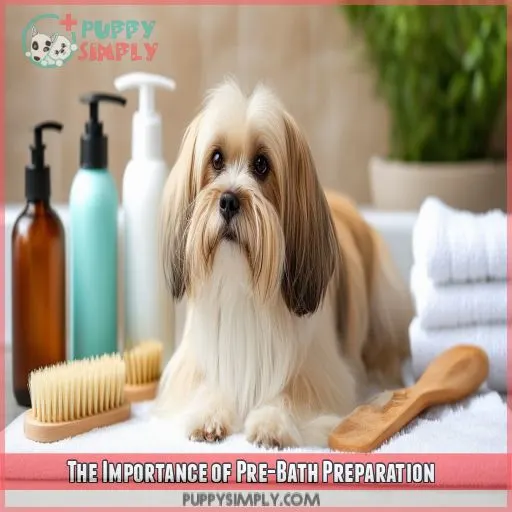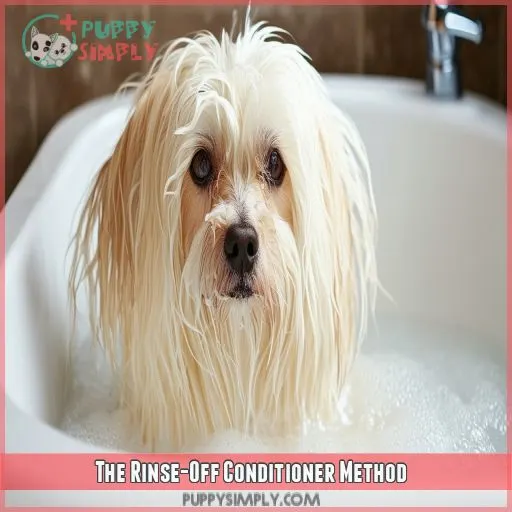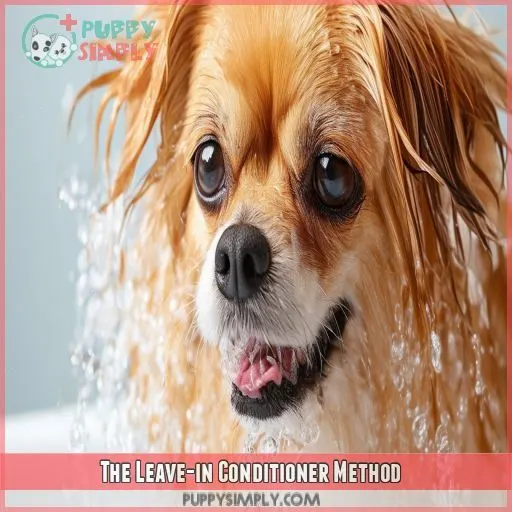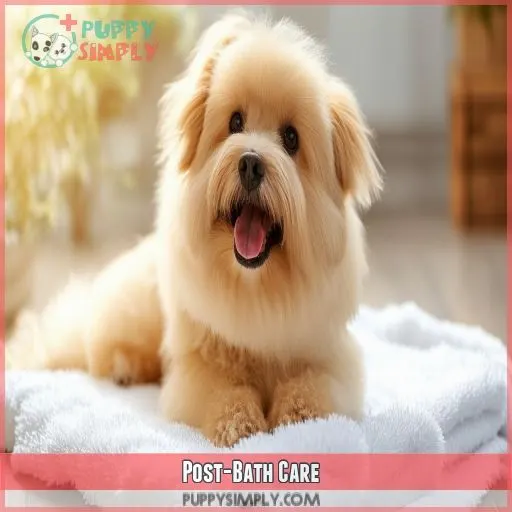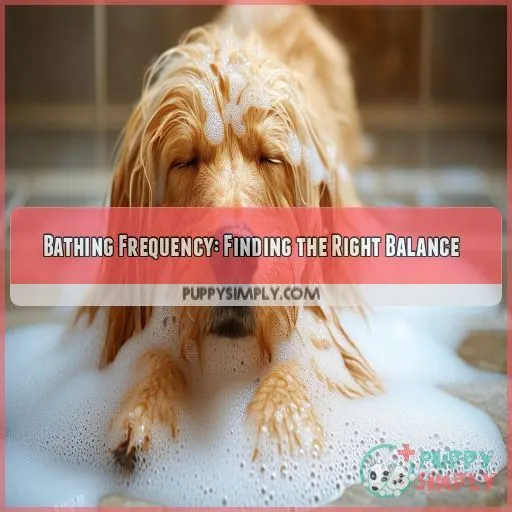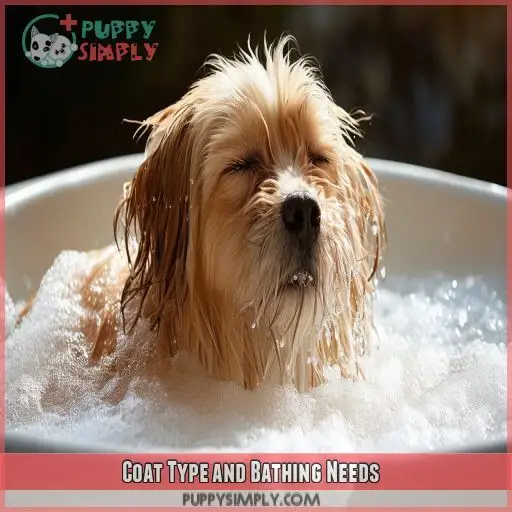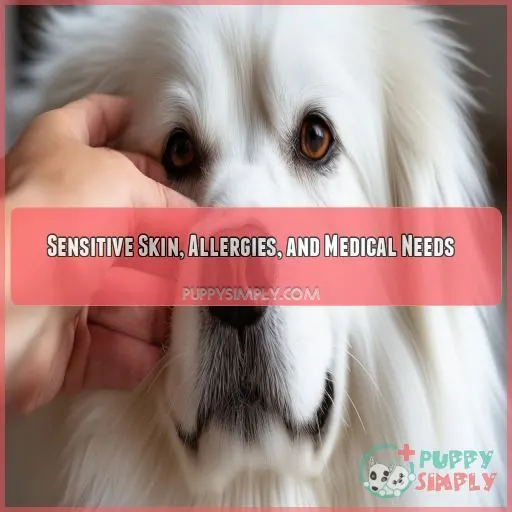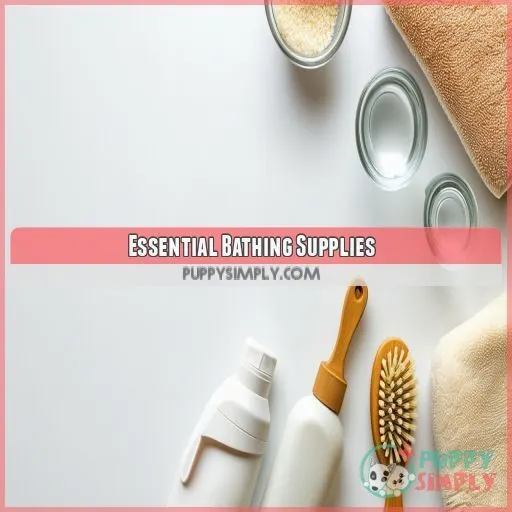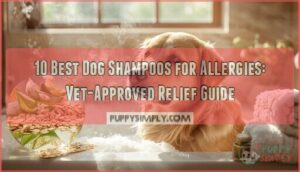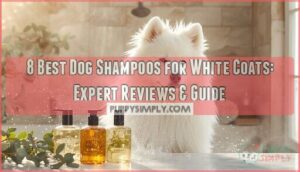This site is supported by our readers. We may earn a commission, at no cost to you, if you purchase through links.
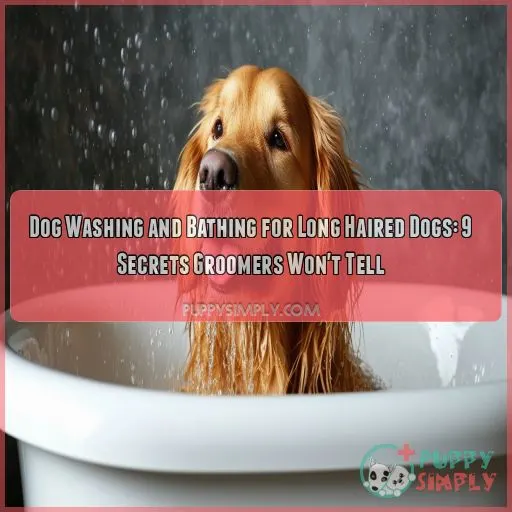
Proper washing and bathing for long-haired dogs can be a challenge, but it’s really important for their health and appearance.
We’ve uncovered 9 secrets that professional groomers often keep to themselves. These tips will help you master the art of bathing your furry friend, ensuring a clean, comfortable, and tangle-free coat.
From pre-bath preparation to post-bath care, you’ll learn the insider techniques to make bath time a breeze for both you and your dog.
Table Of Contents
- Key Takeaways
- The Importance of Pre-Bath Preparation
- The Rinse-Off Conditioner Method
- The Leave-in Conditioner Method
- Post-Bath Care
- Bathing Frequency: Finding the Right Balance
- Coat Type and Bathing Needs
- Sensitive Skin, Allergies, and Medical Needs
- Essential Bathing Supplies
- Frequently Asked Questions (FAQs)
- How do you wash a dog with long hair?
- Do long-haired dogs need a bath?
- Do dogs need a bath?
- Should you bathe a short-haired dog?
- How to properly wash a long haired dog?
- How often should long haired dogs be bathed?
- How to maintain a dog with long hair?
- How to groom a long haired dog at home?
- How do you bathe an aggressive long-haired dog?
- Can you use human hair products on long-haired dogs?
- How to prevent water from getting in dogs eyes?
- Are there waterless bathing options for long-haired dogs?
- How to handle a long-haired dog that hates water?
- Conclusion
Key Takeaways
- Brush before you rush! A thorough pre-bath brushing is your secret weapon against the dreaded "Tangle Monster" that lurks in your long-haired pup’s coat. Plus, it’s a great excuse for some quality bonding time with your furry friend.
- Dilute that shampoo, my friend! Think of it as making a doggy cocktail – not too strong, not too weak. This Goldilocks approach ensures your pooch’s coat gets clean without turning into a sudsy nightmare.
- Leave-in conditioner is your new best friend (after your dog, of course). It’s like a magic potion that turns your pup’s coat from a tangled mess to silky smooth. Your dog will be strutting around like a canine supermodel in no time!
- Don’t go overboard with the bathing schedule. Your long-haired buddy isn’t a fish – once every 6-8 weeks is usually plenty. Too much bathing strips those natural oils faster than a pickpocket at a crowded market. Stick to regular brushing between baths to keep that coat looking fetch!
The Importance of Pre-Bath Preparation
Before you bathe your long-haired dog, it’s important to get things ready so your grooming session goes smoothly. You’ll need to brush out tangles, remove any sticky substances, dilute the shampoo for better coverage, and protect your dog’s ears from water to make sure everything goes well.
Brushing and Removing Debris
Before you start bathing your long-haired pooch, grab that brush!
It’s your secret weapon against matted fur and pesky tangles.
Give your furry friend a thorough once-over, working through their luxurious coat to remove any debris.
This pre-bath brushing session isn’t just about looks – it’s really important for preventing painful knots and excessive shedding later.
Plus, it’s a great bonding time for you and your four-legged companion!
Addressing Sticky Substances
- Apply petroleum jelly or coconut oil to the affected areas
- Let it sit for a few minutes to break down the sticky residue
- Gently work the oil through the fur with your fingers
- Wipe away the loosened gunk with a damp cloth
This pre-bath prep will make washing your long-haired friend a breeze!
Diluting Shampoo
You’re in for a treat!
Diluting shampoo isn’t just a groomer’s trick; it’s a game-changer for your long-haired furry friend.
Don’t go overboard or skimp on the suds; strike the perfect water balance.
Too much shampoo can leave residue, while too little won’t clean effectively.
Mix that pet shampoo with water to create a solution that’ll glide through your dog’s coat like silk, leaving their fur clean and manageable.
Protecting Ears
Now that you’ve diluted your shampoo, let’s protect those precious ears.
You’ll want to keep water out of your dog’s ear canals to prevent infections.
Grab some cotton balls and gently place them in your pup’s ears. Don’t push too deep!
This simple trick acts like earplugs for dogs, keeping water at bay.
It’s especially helpful if your furry friend is prone to ear infections or allergies.
The Rinse-Off Conditioner Method
You’ll start by wetting your dog’s coat thoroughly and applying a diluted shampoo, working it through all layers of hair before rinsing completely. Next, you’ll apply a rinse-off conditioner, massaging it into the coat and then rinsing thoroughly, using your fingers to work through any tangles as you go.
Applying Shampoo
Now that you’ve prepped your long-haired pup, it’s time to lather up!
Dilute your dog shampoo according to the instructions – this helps it penetrate that thick coat.
Start at the neck and work your way down, massaging the suds into their fur.
Don’t forget those hard-to-reach spots!
For extra-stubborn dirt, use a rubber brush to work the lather in.
Your pooch will be squeaky clean in no time!
Thorough Rinsing
Once you’ve lathered your long-haired pup, it’s time for the rinse.
This step is really important to prevent matting and hot spots.
Use lukewarm water and work your fingers through the coat, making sure every inch is thoroughly rinsed.
Don’t rush – a well-rinsed dog is a happy dog!
Keep at it until the water runs clear, paying extra attention to thick areas where soap can hide.
Applying Conditioner
Now that you’ve rinsed out the shampoo, it’s time to apply conditioner. This step is super important for long-haired dogs, as it helps detangle and nourish their luxurious coats. Choose a conditioner specifically designed for your dog’s breed and coat type. Work it through their fur, paying extra attention to problem areas.
- Imagine your pup’s coat becoming silky smooth
- Picture the ease of brushing without tangles
- Envision your dog’s newfound confidence
- Feel the bond strengthen as you care for their coat
Comprehensive Rinsing
After applying conditioner, it’s time for a good rinse.
You’ll want to rinse, rinse, and rinse again. This step takes time and effort, but it’s worth it to prevent skin irritation and matting.
Use a gentle technique, working your fingers through your dog’s coat to make sure every last bit of product is gone.
Different dog breeds and coat types may need varying rinse times, so be patient and thorough.
The Leave-in Conditioner Method
When using the leave-in conditioner method for long-haired dogs, you’ll start by thoroughly wetting your dog’s coat, working from the neck down to avoid getting water in their eyes and ears.
After shampooing with a product designed for long hair, apply a leave-in conditioner or detangler, making sure to distribute it evenly through all layers of the coat.
Before gently towel-drying your dog, make sure the leave-in conditioner or detangler is evenly distributed.
Wetting the Dog
Now that you’ve prepped your long-haired pooch, it’s time to get them wet.
Start by adjusting your water temperature to lukewarm – not too hot, not too cold.
Use a gentle stream of water, starting at the neck and working your way down.
Be careful around the face; you don’t want to startle your furry friend.
Using Special Shampoo
Now that your long-haired pooch is wet, it’s time to lather up with a special shampoo. Dog grooming for long hair requires careful product selection. Here’s why choosing the right shampoo matters:
- Detangles stubborn mats
- Nourishes coat from root to tip
- Prevents future tangles
- Enhances natural shine
Use a shampoo specifically formulated for long-haired breeds. Work it gently through their coat, paying extra attention to areas prone to matting. Remember, the right product can make bath time a breeze!
Applying Leave-in Conditioner
After shampooing, it’s time for the secret weapon: leave-in conditioner.
This magic potion works wonders for long-haired dogs, making detangling a breeze.
Apply it evenly, working it through all layers of your pup’s coat.
Don’t skimp on this step—it’s a game-changer for maintaining that silky, smooth fur.
Your dog groomer mightn’t tell you, but this trick keeps your dog’s coat looking show-ready between appointments.
Towel Drying
After applying leave-in conditioner, it’s time to tackle towel drying. You’ll want to be gentle yet thorough to avoid tangling your long-haired pup’s coat. Pat the fur dry, don’t rub, to prevent matting. Here are some pro tips for effective towel drying:
- Use microfiber towels for better absorption
- Start at the head and work your way down
- Squeeze water out of long fur sections
- Consider a pet-specific drying robe for hands-free absorption
Post-Bath Care
After bathing your long-haired dog, you’ll need to focus on proper drying and post-bath care to keep their coat healthy. Use a blow dryer on a low setting while gently brushing to prevent tangles, protect their eyes from water and shampoo, and don’t forget to place non-slip mats in the bathing area for safety.
Utilizing a Blow Dryer
You’ll want to master the art of blow-drying your long-haired pooch.
Start with a low heat setting to avoid heat damage, and keep the dryer moving constantly.
Use a brush to detangle as you dry, working from roots to tips.
It’s a game-changer for preventing matting and reducing shedding.
Daily Brushing
After blow-drying, you’re not off the hook yet! Daily brushing is really important for long-haired dogs. It’s not just about looks; it’s about your pet’s health and comfort. Here’s why you should make it a routine:
- Prevents matting and tangling
- Reduces shedding and keeps your home cleaner
- Allows you to spot skin issues or hot spots early
Don’t skimp on this step – it’s your secret weapon against pet anxiety and stress caused by uncomfortable coats.
Protecting Eyes
After your daily brushing routine, it’s really important to protect your dog’s eyes during bath time.
Use a gentle, tear-free shampoo and avoid getting water or soap in their eyes to prevent irritation.
For extra safety, apply a dab of mineral oil around their eyes before washing.
If your pup has allergies or anxiety, be extra cautious and consider using a washcloth for their face area.
Using Non-Slip Mats
You’ve nailed the dog washing basics, but here’s a groomer’s secret:
Non-slip mats are your bathtime best friend. They’re not just for show; these unsung heroes provide important traction and stability for your long-haired pooch.
By eliminating slippery hazards, you’ll transform your bathroom into a mini dog spa.
Your furry friend will feel more secure, making the whole grooming process a breeze.
Bathing Frequency: Finding the Right Balance
Bathing your long-haired dog is a balancing act. You need to think about things like your dog’s coat type, skin sensitivity, and overall health to figure out how often to give them a bath. You want to make sure you don’t bathe them too much and strip away their natural oils.
Determining Bathing Frequency
Figuring out how often to wash your dog isn’t a one-size-fits-all thing.
You’ll need to think about your furry friend’s coat type, lifestyle, and how they’re doing.
Some dogs with oily coats might need a bath every week, while others can go longer between washes.
Keep an eye on your dog’s skin and coat, and adjust your grooming routine as needed.
Avoiding Over-Bathing
You’ve got to be careful not to overdo it with dog washing.
Over-bathing can strip your pup’s coat of its natural oils, leaving their skin dry and itchy.
It’s like washing your favorite sweater too often – it just loses its luster.
For most breeds, a bath every 4-6 weeks is plenty.
Considering Health and Skin Sensitivity
While it’s important to avoid over-bathing, you’ll also need to think about your dog’s health and skin sensitivity. Each pup’s unique needs can impact how often you bathe them. Here are some key factors to think about:
- Skin conditions: Dogs with allergies or dermatitis may need special bathing schedules.
- Coat type: Different breeds have varying grooming needs based on their fur.
- Lifestyle: Active dogs or those prone to getting dirty might need more frequent baths.
Coat Type and Bathing Needs
You’ll find that different coat types require unique bathing approaches. Long-haired dogs, for instance, need more frequent brushing and special attention during baths to prevent matting and tangling.
Understanding Different Coat Types
Now that you’ve got a handle on bathing frequency, let’s talk about coat types. Understanding your dog’s unique fur can be a game-changer in your grooming routine. Here’s a quick guide to help you identify and care for different coat textures:
| Coat Type | Texture | Shedding Level |
|---|---|---|
| Smooth | Short, sleek | Low to moderate |
| Double | Dense undercoat | Heavy |
| Long | Silky or coarse | Varies |
| Wire | Rough, bristly | Low |
Considering Brushing and Bathing Needs for Each Type
You’ll need to tailor your grooming routine to your dog’s specific coat type. Each breed has unique needs, so it’s important to understand what works best for your furry friend. Here’s a quick rundown of different coat types and their grooming requirements:
- Silky coats: Think Yorkies – they need daily brushing and frequent baths
- Double coats: Labs and Huskies require regular de-shedding and less frequent bathing
- Curly coats: Poodles need consistent brushing and professional grooming
- Wire coats: Terriers benefit from hand-stripping and occasional baths
- Long, flowing coats: Afghans demand daily brushing and careful bathing techniques
Sensitive Skin, Allergies, and Medical Needs
If your long-haired dog has sensitive skin or allergies, you’ll need to tailor your bathing schedule and use specialized products. Work with your vet to determine the right frequency for baths and consider using prescription shampoos or medicated treatments to manage skin issues effectively.
Tailoring Bathing Schedules
You’ve learned about coat types, but what if your furry friend has special needs?
Tailoring bathing schedules for sensitive skin, allergies, or medical conditions is really important.
Consider factors like your dog’s health, breed, and lifestyle when setting a frequency.
A professional pet groomer can help you find the right balance.
Using Prescription Shampoo
When your furry friend has sensitive skin, allergies, or medical needs, prescription shampoos become your secret weapon.
These vet-approved formulas are made specifically for certain issues, from pesky pet fleas to stubborn bacteria.
But don’t go overboard! Follow your vet’s recommended bathing schedule to avoid drying out your pup’s skin.
Managing Skin Allergies
After using prescription shampoo, managing skin allergies is important. If your long-haired pup’s itching persists, it’s time to tackle those pesky triggers. Here’s your game plan:
- Identify common culprits: pollen, dust, or certain foods
- Bathe more frequently to remove allergens
- Use hypoallergenic, fragrance-free dog shampoos
- Consider flea treatments, as these pests can exacerbate allergies
Regular grooming isn’t just about looking sharp; it’s your secret weapon against infections and skin irritations. Remember, a clean dog is a happy dog!
Essential Bathing Supplies
You’ll need the right tools to bathe your long-haired dog effectively, including a suitable brush, dog-specific shampoo, and non-slip mats for the bathtub. Don’t forget to clean your dog’s ears thoroughly after bathing to prevent infections, and consider using a leave-in conditioner to keep their coat manageable.
Selecting Appropriate Brushes and Shampoos
You’ll need the right tools to tame your long-haired pooch’s mane. Let’s explore the different brushes and shampoos that’ll make your dog washing process a breeze. From detangling to de-shedding, we’ve got you covered. Here’s a quick guide to essential grooming tools:
| Brush Type | Best For | Coat Type | Usage Frequency | Special Features |
|---|---|---|---|---|
| Slicker Brush | Removing mats and tangles | Long, thick coats | Daily | Wire bristles |
| Pin Brush | Detangling and smoothing | All coat types | Weekly | Rounded tips |
| Bristle Brush | Distributing natural oils | Short, smooth coats | Daily | Natural bristles |
| Undercoat Rake | Removing loose undercoat | Double coats | Weekly | Wide-set teeth |
| Dematting Tool | Breaking up stubborn mats | Long, matted coats | As needed | Sharp blades |
Utilizing Bathtub Supplies
You’ve got the right brushes and shampoos, now let’s talk tub time.
Don’t let your furry friend slip and slide! Invest in non-slip or rubber mats to transform your bathroom into a pet spa. These bath mats are a game-changer for tub safety, giving your long-haired pooch solid footing.
While you’re at it, why not make bathtime a dental session? Grab a doggy toothbrush and turn that spa into a full-service grooming experience!
Cleaning Ears Thoroughly
You’ve got to keep those floppy ears squeaky clean!
It’s not just about looks; ear cleanliness is important for your long-haired pup’s health.
Make ear cleaning a regular part of your grooming routine to prevent pesky infections.
After bathing, gently wipe the outer ear with a soft cloth or cotton ball.
For deeper cleaning, use a vet-approved ear cleaner.
Frequently Asked Questions (FAQs)
How do you wash a dog with long hair?
Brush thoroughly, then wet your dog’s coat. Apply diluted shampoo, working from neck to tail. Rinse completely, then use conditioner. Rinse again, gently detangling as you go. Pat dry with towels and blow-dry on low heat.
Do long-haired dogs need a bath?
Yes, long-haired dogs need baths, but less frequently than you might think. You’ll want to bathe them every 6-8 weeks, or when they’re visibly dirty. Regular brushing can help extend time between baths.
Do dogs need a bath?
You bathe your dog to keep them clean, healthy, and smelling fresh. How often depends on their breed, lifestyle, and coat type. Frequent baths can strip natural oils, so find the right balance for your furry friend.
Should you bathe a short-haired dog?
You should bathe short-haired dogs less frequently than their long-haired counterparts. They typically need baths every 3-4 months, unless they’re visibly dirty or smelly. Regular brushing can help extend the time between baths for short-haired pups.
How to properly wash a long haired dog?
You’ll need to brush thoroughly before bathing. Use dog-specific shampoo, dilute it, and work it through all layers of hair. Rinse completely, apply conditioner, and rinse again. Dry carefully to prevent tangles and matting.
How often should long haired dogs be bathed?
Yo dawg, don’t overdo the splash zone! Long-haired pups shouldn’t be bathed more than once a month. You’ll strip their natural oils if you wash ’em too often. Brush regularly and spot-clean when needed to keep ’em fresh.
How to maintain a dog with long hair?
Brush your long-haired dog daily to prevent matting. Trim regularly, especially around paws and ears. Use a detangling spray for stubborn knots. Bathe monthly with dog-specific shampoo. Keep their coat clean and free from debris between washes.
How to groom a long haired dog at home?
You’ll be a grooming wizard in no time! Brush daily to prevent tangles, trim fur regularly, bathe monthly using dog-specific shampoo, and don’t forget those nails. For a pro touch, invest in quality grooming tools and practice patience.
How do you bathe an aggressive long-haired dog?
You’ll need patience and caution. Use a muzzle, secure the dog, and work slowly. Offer treats and speak calmly. Start with short sessions, focusing on positive experiences. Consider professional help if aggression persists or worsens.
Can you use human hair products on long-haired dogs?
Imagine using a jackhammer to slice bread – that’s how harsh human shampoo is on your dog’s skin. You shouldn’t use human hair products on long-haired dogs. They’re too acidic and can damage your pup’s coat and skin.
How to prevent water from getting in dogs eyes?
To protect your dog’s eyes during baths, apply mineral oil around the eye area, creating a barrier. Use a washcloth to gently clean the face, and direct water flow away from their eyes while rinsing. Don’t forget to praise them!
Are there waterless bathing options for long-haired dogs?
Good news! Waterless options exist. You’ll find dry shampoos, cleansing wipes, and foam cleansers that’ll keep your long-haired pup clean without the hassle of water. They’re quick, convenient, and perfect for between-bath touch-ups.
How to handle a long-haired dog that hates water?
Start with gentle desensitization, using treats and positive reinforcement. Try waterless shampoos or damp towels for cleaning. When bathing’s necessary, use a non-slip mat, warm water, and a handheld sprayer. Keep sessions short and reward your pup generously.
Conclusion
Washing and bathing a long-haired dog doesn’t have to be a big deal.
By following these pro grooming tips, you can turn bath time from a chore into a fun routine.
Remember to adjust your approach to your dog’s specific needs, like their coat type, skin sensitivity, and overall health.
With the right techniques and tools, you’ll keep your furry friend’s coat clean, comfortable, and tangle-free.
Use these expert tips, and you’ll soon be bathing your long-haired companion like a pro.

